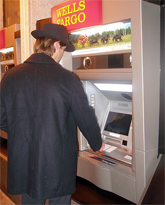Wells Fargo Ordered To Pay $203 Million For Processing Transactions High To Low, Maximizing Overdraft Fees

(nmmercer)
A California judge ordered Wells Fargo to pay California customers $203 after finding that the bank had deliberately manipulated the way it processed transactions in a way that turned one overdraft fee into as many as 10, at $35 a pop.
Internal bank memos, the judge said, showed that after 2001, along with many other banks, Wells Fargo decided to change the way it processed account transactions from low to high to high to low. In addition, ACH and check transactions were commingled with debit, whereas before they had been separate.
In his 90-page ruling, the judge wrote:
Internal bank memos and emails leave no doubt that, overdraft revenue being a big profit center, the bank’s dominant, indeed sole, motive was to maximize the number of overdrafts and squeeze as much as possible out of what it called its “ODRI customers” (overdraft/returned item) and particularly out of the four percent of ODRI customers it recognized supplied a whopping 40 percent of its total overdraft and returned-item revenue.
…In the February 2002 BSE memo, the bank explained that the December 2001 commingling change was designed “to more-closely mirror true High-to-Low sort order” (TX 36). This is significant because Wells Fargo knew — and its own expert witness, Professor Christopher James, confirmed at trial — that high-to-low posting
would “mechanically . . . lead to more overdrafts” than other posting order (Tr. 613, 1863-64). It is a mathematical certainty.Weighing all of the evidence presented at trial, this order finds that gouging and profiteering were Wells Fargo’s true motivations behind the high-to-low switch and the allied practices that soon followed. High-to-low posting was adopted exclusively to generate more overdraft fees and fee revenue at the expense of depositors. The two closely allied practices that followed were similarly motivated by a singular desire to boost overdraft fee revenue using the bank’s high-to-low bookkeeping device. While these changes occurred prior to the class period, they set the stage for the profiteering that ran rampant during the class period and continues even now.
In their defense, Wells Fargo argued that their customers wanted and benefited from high to low transaction processing, saying that depositors would rather have multiple small transactions bounce than a single rent payment bounce. However, at trial they did not present any evidence beyond the hypothetical to support this notion.
Wells Fargo plans to appeal.
Wells Fargo loses overdraft fee case [CNN Money] (Thanks to Alice!)
Full text of ruling (PDF)
Want more consumer news? Visit our parent organization, Consumer Reports, for the latest on scams, recalls, and other consumer issues.

